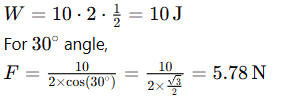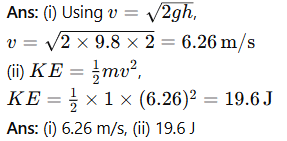Numerical Questions : WORK & ENERGY - Class 9 PDF Download
Some Numerical Questions: WORK & ENERGY
Q. 1 A force of 10N causes a displacement of 2m in a body in its direction. Calculate the work done by force.
Ans: Work done (W) = Force (F) × Displacement (d)
J
Ans: 20 J
Q. 2 How much force is applied on the body when 150 J of work is done in displacing the body through a distance of 10m in the direction of force?
Ans: Using the formula , we rearrange to find .
Ans: 15 N
Q. 3 A body of 5kg is raised to 2m. Find the work done.
Ans: Work done , where g.
J
Ans: 98 J
Q. 4 A work of 4900 J is done on a load of mass 50 kg to lift it to a certain height. Calculate the height through which the load is lifted.
Ans: Using , rearrange to .
m
Ans: 10 m
Q. 5 An engine does 54,000 J of work by exerting a force of 6000 N. What is the displacement?
Ans: Displacement d=FW.
m
Ans: 9 m
Q. 6 A force of 10 N acting on a body at an angle of 60∘ with the horizontal direction displaces the body through a distance of 2 m along the surface. Calculate the work done. Now, let the force make an angle of 30∘ with the horizontal. What is the value of the force to displace the body through 2m along the surface?
Ans:
Q. 7 A force of 5 N acting on a body at an angle of 30∘ with the horizontal direction displaces it horizontally through a distance of 6 m. Calculate the work done.
Ans: Work done .
J
Ans: J
Q. 8 A body of mass 2 kg is moving with a speed of 20 m/s. Find the kinetic energy.
Ans: Kinetic energy
J
Ans: 400 J
Q. 9 A moving body of 30 kg has 60 J of KE. Calculate the speed.
Ans: Using , rearrange to 
 A
A
Ans: 2 m/s
Q. 10 A hammer of mass 1 kg falls freely from a height of 2 m. Calculate (i) the velocity, and (ii) the KE just before it touches the ground.
Q. 11 Calculate the energy possessed by a stone of mass 10 kg kept at a height of 5 m. If 196×102J of energy were used to raise a 40 kg boy above the ground, how high would he be raised?
Ans: For the stone, .
J
Ans: 490 J for the stone, 50 m for the boy
Q. 12 Calculate the change in velocity required to maintain the same KE if the mass of a body is increased to 4 times its original value.
Ans: To maintain the same KE, the new velocity (half the original velocity).
Half the original velocity
Q. 13 A machine does 192 J of work in 240 seconds. What is the power of the machine?
Ans: Power .
W
Ans: 0.8 W
Q. 14 A person weighing 50 kg runs up a hill, rising vertically 10 m in 20 seconds. Calculate power, given g=9.8m/s2.
Ans: Power .
W
Ans: 245 W
Q. 15 A rickshaw puller applies a force of 100 N, moving the rickshaw at a constant velocity of 36 km/h. Find the power of the rickshaw puller.
Ans: Convert velocity to m/s: m/s.
W
Ans: 1000 W
FAQs on Numerical Questions : WORK & ENERGY - Class 9
| 1. What is the work done when a force is applied but there is no displacement? |  |
| 2. How is kinetic energy calculated in a moving object? |  |
| 3. What is the relationship between work and energy in a mechanical system? |  |
| 4. What are the different forms of energy related to work and energy concepts? |  |
| 5. How does gravitational potential energy change when an object is lifted? |  |















